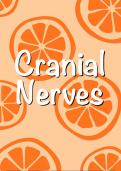Cranial
Nerves
, Overview
Cranial Nerves
12 pairs of cranial nerves (CNs) leave the brain and pass through foramina and fissures in the skull.
Carry afferent & efferent fibres between brain & peripheral structures, principally of head & neck.
Numbered with roman numerals according to exit of brain
CN I and II are extensions of forebrain
CN III-XII exit from brainstem (except XI has spinal roots also)
Mnemonics
Oh, Oh, Oh, To Touch And Feel Very Good Velvet Absolute Heaven
Olfactory (CNI), Optic (CNII), Oculomotor (CNIII), Trochlear (CNIV), Trigeminal (CNV), Abducens (CNVI), Facial (CNVII)
Vestibulocochlear (CNVIII), Glossopharyngeal (CNIX), Vagus (CNX), Accessory (CNXI), Hypoglossal (CNXII)
Some Say Money Matters But My Brother Says Big Brains Matter Most
S - sensory M - motor B - both
Cranial Nerves at the Base of the Brain
Olfactory nerves (I) & optic nerves (II) arise from base of forebrain of the cerebrum
Olfactory system is associated, structurally & functionally, with parts of forebrain (collectively
- limbic system)
Cranial Nerves associated with Cranial Nuclei
Sensory Motor
Can be divided into two groups, the afferent and efferent nuclei, each being generally aligned
to functional columns in the brain stem
Afferent Nuclei
Trigeminal sensory nucleus: receives sensory info from head through trigeminal nerve
at level of pons, runs length of brainstem & extends caudally into cervical spinal cord.
Vestibular & cochlear nuclei: recieves info (motion/positional sense & hearing) from
vestibulocochlear nerve info located in medulla, in & near to lateral part of floor of fourth ventricle
Nucleus solitarius: Visceral afferents, including taste fibres, terminate here, in medulla.
Efferent nuclei
On basis of embryological derivation, efferent cranial nerve nuclei divided into three groups (somatic efferent, branchiomotor
& parasympathetic), each lying in a discontinuous longitudinal column.
Somatic efferent cell column —lies near midline, consists of nuclei of III, IV, VI & XII nerves.
Oculomotor nucleus: efferent fibres run in oculomotor nerve to innervate levator palpebrae superioris & extraocular muscles
(except superior oblique & lateral rectus), lies in ventral apex of periaqueductal grey of midbrain at level of superior colliculus
Trochlear nucleus: fibres leave in trochlear nerve, to innervate superior oblique muscle of eye, lies in midbrain at ventral
border of periaqueductal grey, but at level of inferior colliculus
Abducens nucleus: efferents run in abducens nerve & innervate lateral rectus muscle,
located in caudal pons beneath floor of fourth ventricle
Hypoglossal nucleus: innervates intrinsic & extrinsic muscles of tongue via hypoglossal nerve, lies in medulla
Branchiomotor cell column —innervates striated muscles derived from branchial arches
Trigeminal motor nucleus: supplies fibres to trigeminal nerve & innervates muscles of mastication, tensor tympani, tensor
veli palatini, mylohyoid & anterior belly of digastric muscle, in tegmentum of midline mid-pons
Facial motor nucleus: innervates muscles of facial expression & stapedius via facial nerve, in caudal pontine tegmentum
Nucleus ambiguus: long nucleus sends motor fibres in the glossopharyngeal, vagus and cranial part of the accessory nerve
to innervate the muscles of the pharynx and larynx, within medulla




